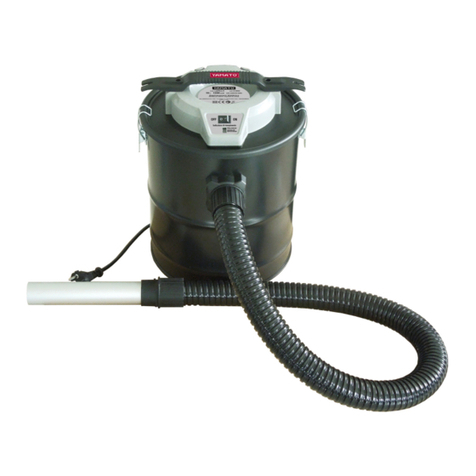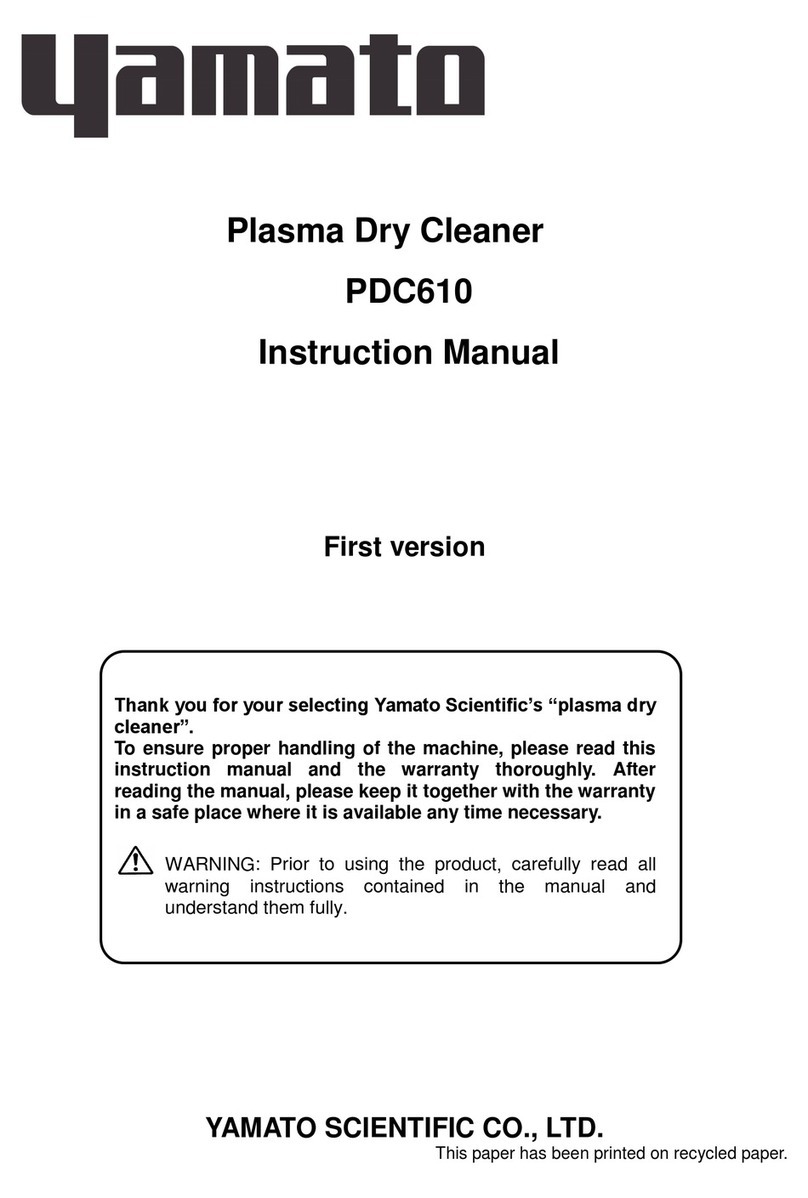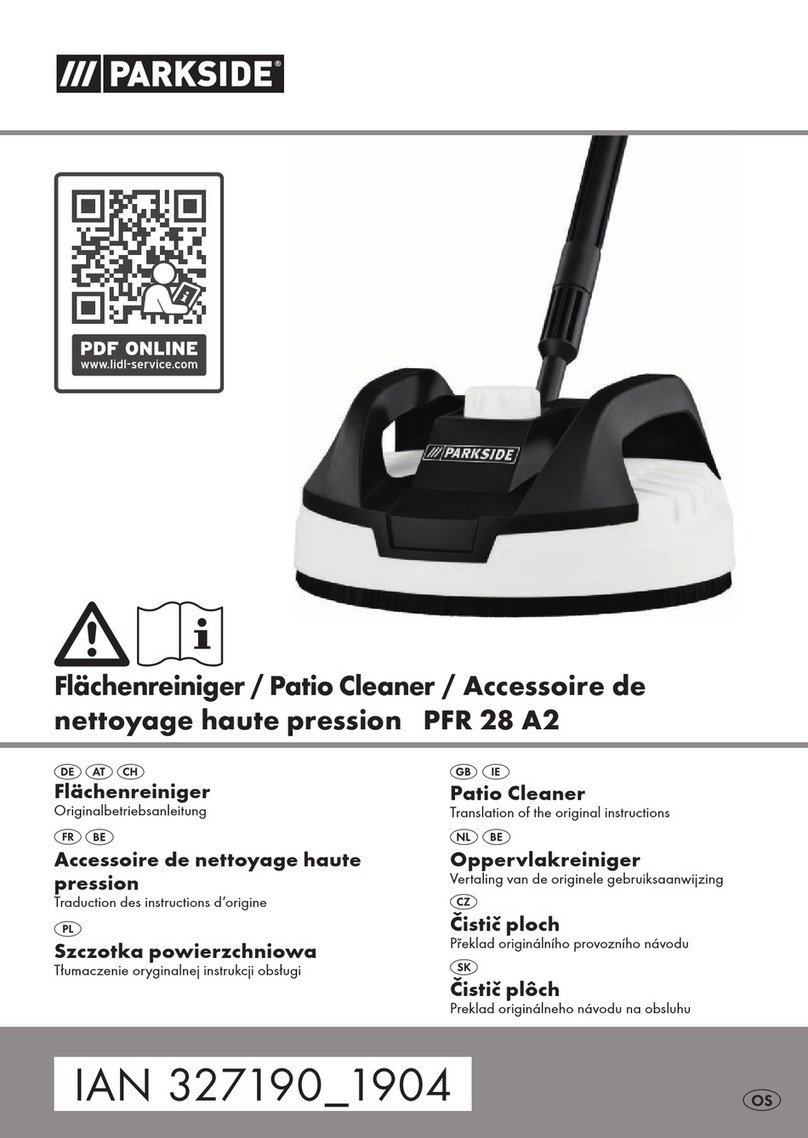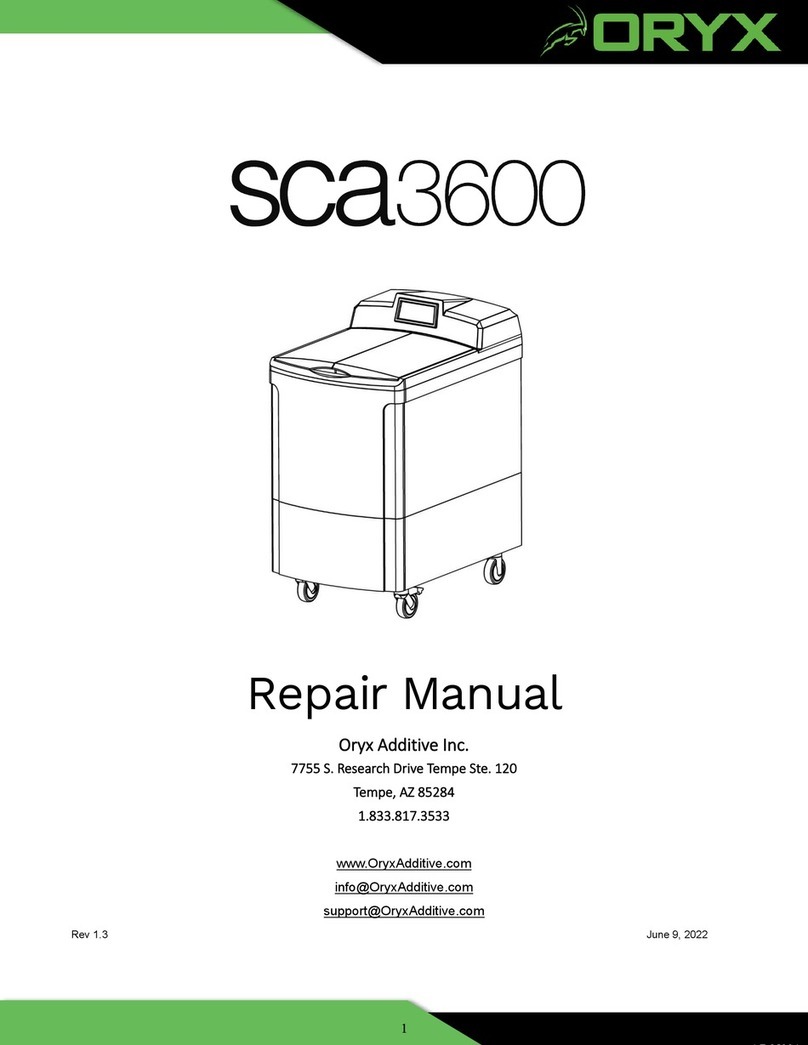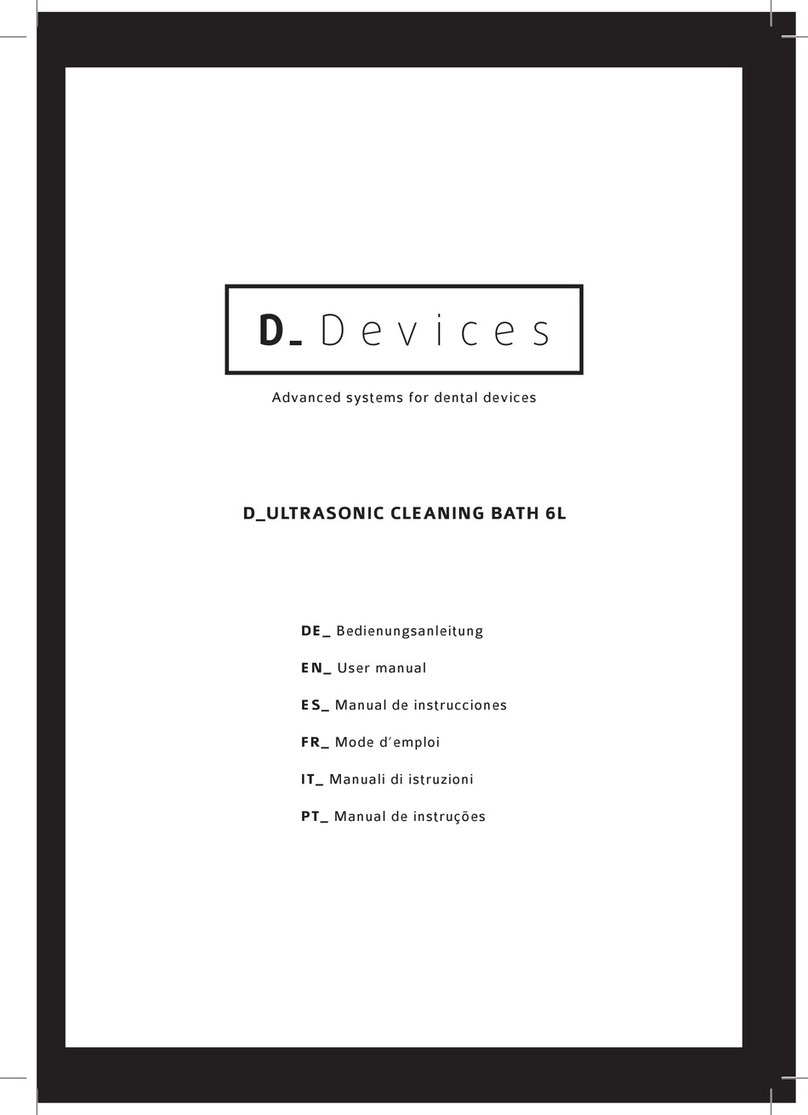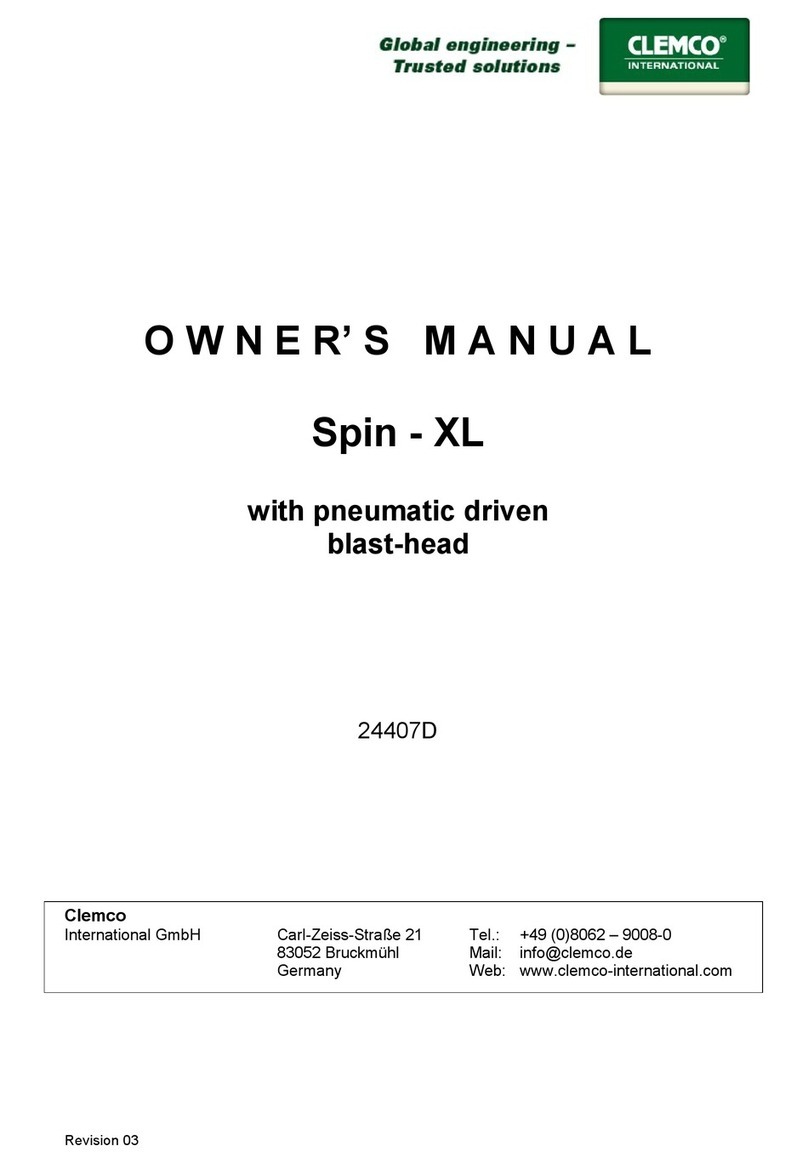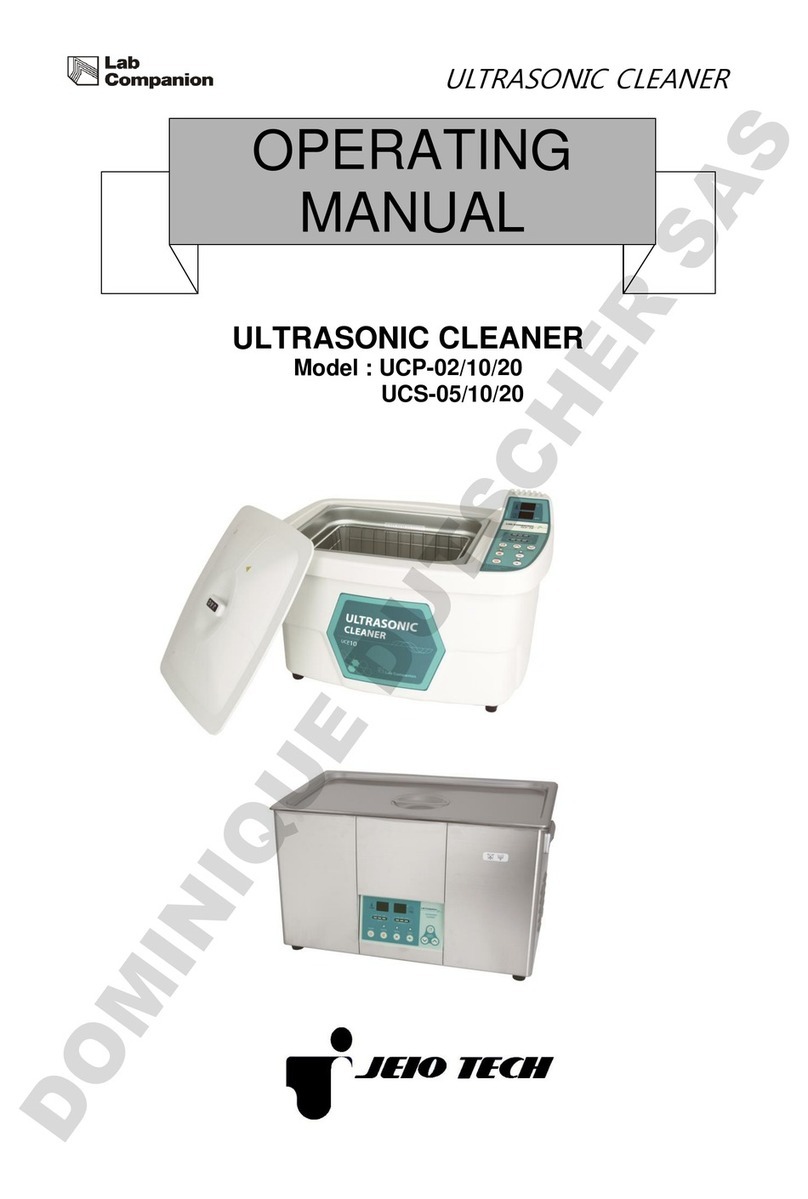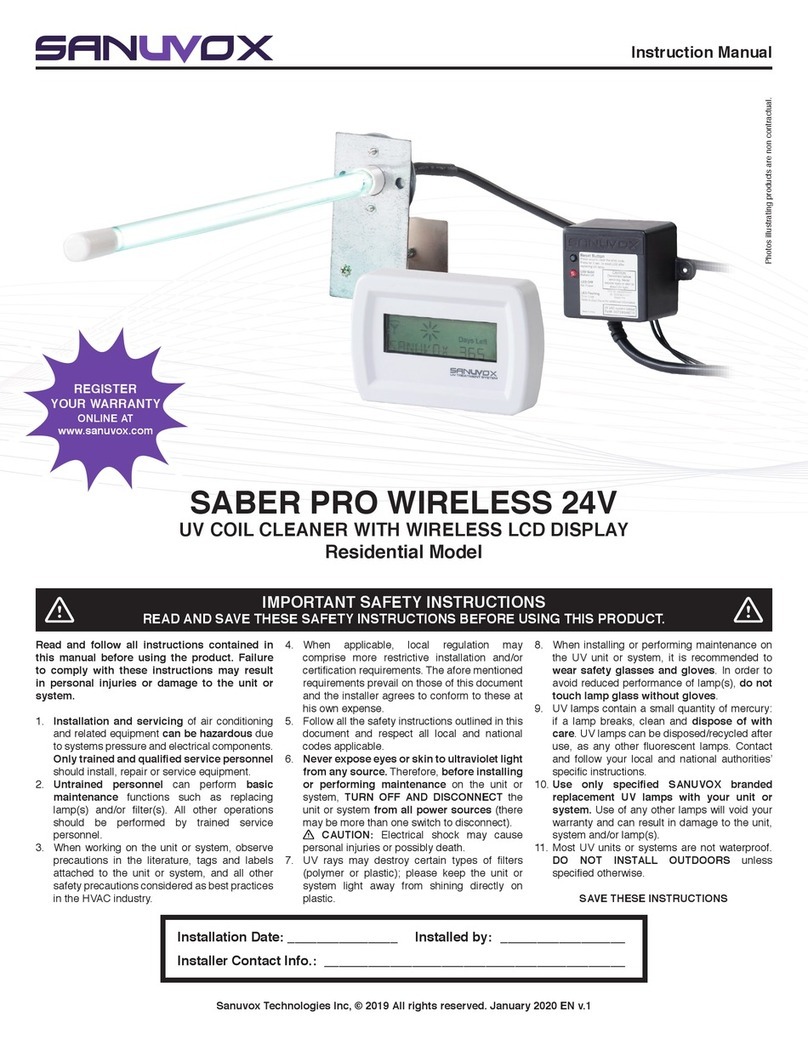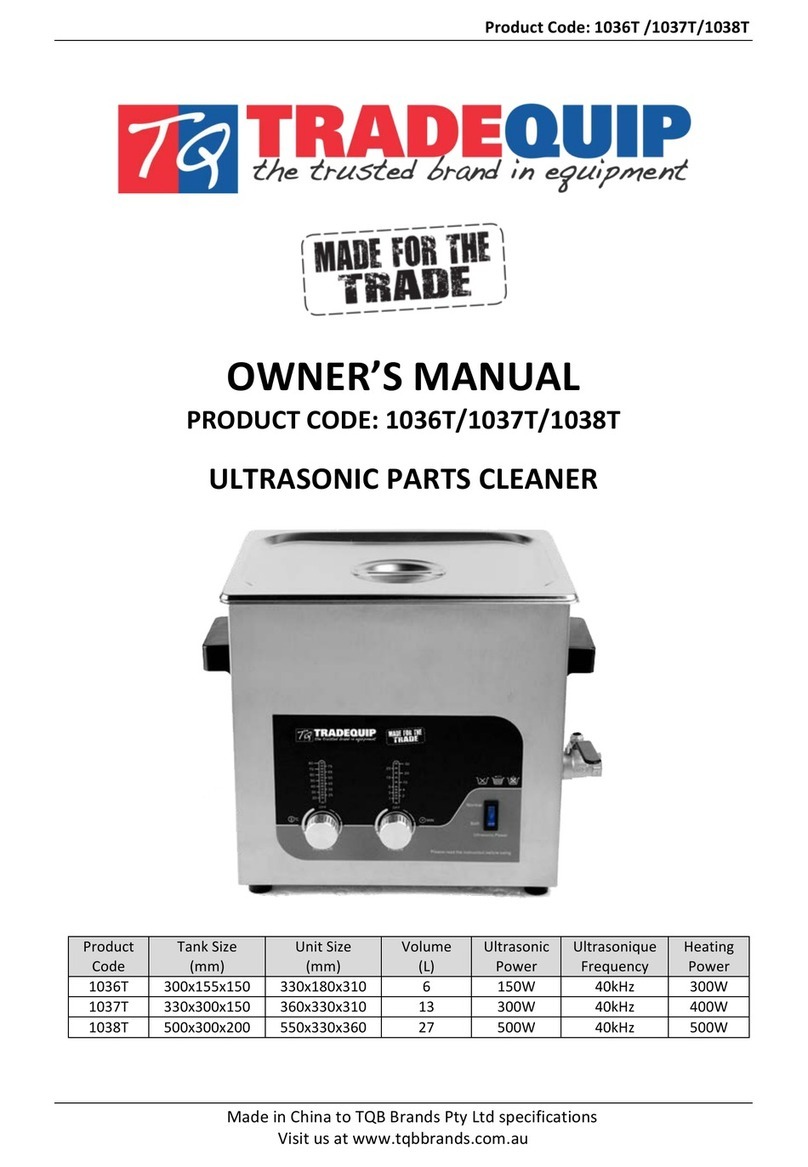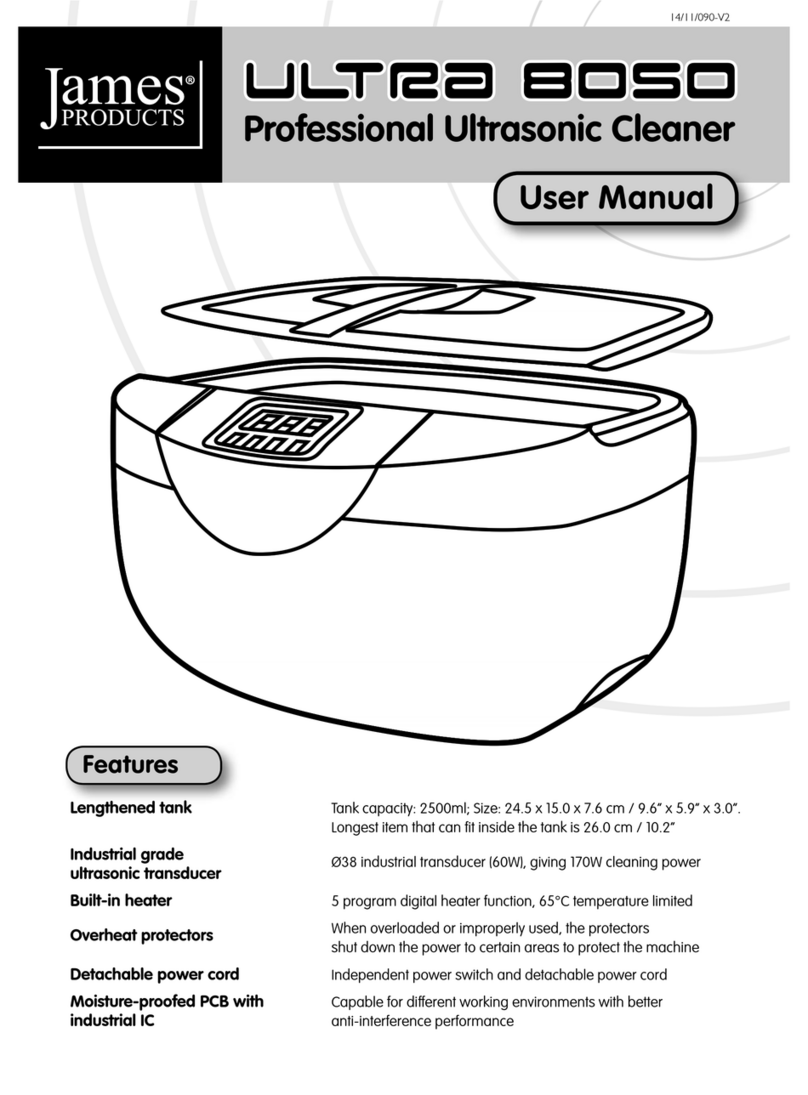Yamato PDC510 User manual

YAMATO SCIENTIFIC CO., LTD.
Plasma Dry Cleaner
PDC510
Instruction Manual
Version 1
Thank you for your selecting Yamato Scientific’s
“plasma dry cleaner”.
To ensure proper handling of the machine, please read
this instruction manual and the warranty thoroughly.
After reading the manual, please keep it together with
the warranty in a safe place where it is available any
time necessary.
WARNING: Prior to using the product, carefully read all
warning instructions contained in the man-
ual and understand them fully.


Table of Contents
1. SAFETY PRECAUTION
1. SAFETY PRECAUTION1. SAFETY PRECAUTION
1. SAFETY PRECAUTIONS
SS
S
................................
................................................................
................................................................
................................................................
................................................................
................................................................
......................................
............
......
1
11
1
Description of Warning Symbols ..............................................................................1
A List of Symbols......................................................................................................2
Warning and Caution................................................................................................3
2. PRIOR TO USE
2. PRIOR TO USE2. PRIOR TO USE
2. PRIOR TO USE
................................
................................................................
................................................................
................................................................
................................................................
................................................................
......................................................
............................................
......................
4
44
4
Precautions for Installation.......................................................................................4
3. COMPONENTS AND FU
3. COMPONENTS AND FU3. COMPONENTS AND FU
3. COMPONENTS AND FUNCTIONS
NCTIONSNCTIONS
NCTIONS
................................
................................................................
................................................................
................................................................
......................................................
............................................
......................
5
55
5
Main Unit..................................................................................................................5
Back of the Main Unit...............................................................................................6
4. INSTALLATION METH
4. INSTALLATION METH4. INSTALLATION METH
4. INSTALLATION METHOD
ODOD
OD
................................
................................................................
................................................................
................................................................
................................................................
................................................................
...................................
......
...
7
77
7
Required Equipment / Methods to Connect Cables and Tubes................................7
Processing Mode Changeover Method....................................................................8
Auto-Tuning adjustment procedure..........................................................................9
5. RUNNING PROCEDURE
5. RUNNING PROCEDURE5. RUNNING PROCEDURE
5. RUNNING PROCEDURE
................................
................................................................
................................................................
................................................................
................................................................
................................................................
....................................
........
....
10
1010
10
Operation inAuto Run............................................................................................10
Running Procedure................................................................................................11
Touch Panel Operation...........................................................................................13
6. PRECAUTIONS FOR H
6. PRECAUTIONS FOR H6. PRECAUTIONS FOR H
6. PRECAUTIONS FOR HANDLING
ANDLINGANDLING
ANDLING
................................
................................................................
................................................................
................................................................
.....................................................
..........................................
.....................
19
1919
19
Warning and Caution ..................................................................................19
7. MAINTENANCE
7. MAINTENANCE7. MAINTENANCE
7. MAINTENANCE
................................
................................................................
................................................................
................................................................
................................................................
................................................................
..................................................
....................................
..................
20
2020
20
Daily Inspection......................................................................................................20
Periodic Inspection.................................................................................................21
8. ALARMS AND CORREC
8. ALARMS AND CORREC8. ALARMS AND CORREC
8. ALARMS AND CORRECTIVE ACTIONS
TIVE ACTIONSTIVE ACTIONS
TIVE ACTIONS................................
................................................................
................................................................
................................................................
............................................
........................
............
22
2222
22
Alarms and Corrective Actions...............................................................................22
9. AFTER
9. AFTER9. AFTER
9. AFTER
SALE SERVICE AND WAR
SALE SERVICE AND WARSALE SERVICE AND WAR
SALE SERVICE AND WARRANT
RANTRANT
RANTY
YY
Y
................................
................................................................
................................................................
................................................................
.......................................
..............
.......
23
2323
23
Request for Repair.................................................................................................23
10. SPECIFICATIONS
10. SPECIFICATIONS10. SPECIFICATIONS
10. SPECIFICATIONS
................................
................................................................
................................................................
................................................................
................................................................
................................................................
.............................................
..........................
.............
24
2424
24
Specifications.........................................................................................................24
11. WIRING DIAGRAM
11. WIRING DIAGRAM11. WIRING DIAGRAM
11. WIRING DIAGRAM
................................
................................................................
................................................................
................................................................
................................................................
................................................................
...........................................
......................
...........
25
2525
25
12.GAS/PRESSURE DELI
12.GAS/PRESSURE DELI12.GAS/PRESSURE DELI
12.GAS/PRESSURE DELIVERY MODULE
VERY MODULEVERY MODULE
VERY MODULE
................................
................................................................
................................................................
................................................................
............................................
........................
............
26
2626
26
13.
13. 13.
13. PARTS LIST
PARTS LISTPARTS LIST
PARTS LIST
................................
................................................................
................................................................
................................................................
................................................................
................................................................
.......................................................
..............................................
.......................
27
2727
27
14. DISPOSAL
14. DISPOSAL14. DISPOSAL
14. DISPOSAL
................................
................................................................
................................................................
................................................................
................................................................
................................................................
..........................................................
....................................................
..........................
28
2828
28
Precautions for Disposal ........................................................................................28
15. LI
15. LI15. LI
15. LIST OF HAZARDOUS SUBS
ST OF HAZARDOUS SUBSST OF HAZARDOUS SUBS
ST OF HAZARDOUS SUBSTANCES
TANCESTANCES
TANCES
................................
................................................................
................................................................
................................................................
............................................
........................
............
29
2929
29

1
1. SAFETY PRECAUTIONS
Description of Warning Symbols
Warning Symbols
Various warning symbols are contained in the manual and attached
to the product to ensure safe use. Accidents which may result
from mishandling are classified as follows.
Understand them fully before reading the body.
WARNING
Indicates matters that may cause possible death or
serious injury (Note 1).
CAUTION
Indicates matters that may cause possible minor injury
(Note 2) and damage to property (Note 3).
Note 1: Serious injury refers to injuries, electric shock, fracture, poisoning, etc.
which will entail after effects and those which will require hospitalization or
long-time treatment to be cured.
Note 2: Minor injury refers to injuries, electric shock, etc. which will not require
hospitalization or long-time treatment to be cured.
Note 3: Damage to property refers to damages to property such as facilities,
equipment and buildings.
Meaning of Symbols
This symbol indicates matters that concern “warning” (including caution).
Specific contents of warning are provided near this symbol.
This symbol indicates prohibited matters.
Specific contents of prohibition are provided near this symbol.
This symbol indicates matters that must be performed.
Specific contents of instruction are provided near this symbol.

2
1. SAFETY PRECAUTIONS
A List of Symbols
WARNING
General High Voltage High Temp. Drive Unit Explosion
CAUTION
General Electric Shock Burn
PROHIBITED
General No Disassembly No Contact
COMPULSORY
General Connect Ground
Wire Install Horizontally Unplug Power Periodic Inspection

3
1. SAFETY PRECAUTIONS
Warning and Caution
Warning
1. Never use the machine in atmosphere containing ignitable and explosive
gases.
Never use the machine in atmosphere containing ignitable and explosive gases. The ma-
chine is not of explosion-proof construction. Turning on and off the switches and operating
the machine will produce sparks, which may become a cause of a fire or explosion. (See
13. List of Hazardous Substances on page 26.)
2. Never use explosive and flammable substances.
Never use explosive and flammable substances and substances containing such substanc-
es. The machine is not equipped with safety features against such substances. They are
a cause of explosion and fire.
3. Never use the machine in abnormal conditions.
If you notice smoke, offensive odor or other problems, immediately turn off the circuit breaker
of the machine and also turn off the power of the distribution panel on the building side.
They are a cause of a fire and electric shock.
4. Never disassemble or modify the machine.
The machine must not be disassembled or modified by the user. Unauthorized disas-
sembly and modification are a cause of failure, fire, electric shock and other accidents.
5. Handling of the power cords.
Do not use bundled power cords. Such a way of use may cause the cords to overheat to
cause a fire.
Do not machine power cords or bend, twist or pull them by undue force. Hazard of a fire
and electric shock.
Do not damage power cords by for example placing them under a desk or chair or clamping
them by devices. Hazard of a fire and electric shock.
Do not bring power cords near heating devices such as a heater. The coating of the cords
will be burnt to cause a fire or electric shock.
If a power cord is damaged (core wires exposed or broken), immediately turn off the power
of the machine and also turn off the source power supply. Then request the dealer for re-
placement of the cord. If such damaged cords are used, a fire or electric shock may result.
6. Be sure to use the specified reaction gas.
Be sure to use the specified processing gas (argon gas, oxygen optional). If other gas is
used, the actual flow rate becomes different from the indicated flow rate. Also other prob-
lems such as damage to products and insufficient cleaning may happen.

4
2. PRIOR TO USE
Precautions for Installation
Warning
1. Be sure to connect the ground wire.
・ To prevent electric shock accidents due to fault current, be sure to connect the ground
wire to the ground terminal on the building side. This machine falls in the category of
Class D Ground Work.
・ Never connect the ground wire to a gas pipe, water pipe, ground wire of a telephone or
lightning conductor. Hazard of a fire and electric shock.
2. Select a suitable installation site.
Do not install the machine in the following places:
・An unstable place.
・A place where flammable or corrosive gas is produced.
・A place where ambient temperature rises above 35℃.
・A place where temperature changes largely.
・A place filled with dust or a humid place.
・A place under direct sunlight.
・A place that is subjected to vibrations.
3. Install the machine on a level foundation.
Install the machine on a level foundation. If the machine is not in contact with the floor
uniformly, vibration and noise may be produced. Also unexpected troubles or failures may
occur.
4. Use a suitable distribution panel.
Use a distribution panel that is suitable for the electric rating of the machine.
Electric rating: 3-phase, 220 VAC, 20A, 50/60 Hz
If the capacity is insufficient or the machine is used on a line to which other equipment is
connected, the machine may not function properly or the circuit breaker in the distribution
panel may operate.

5
3. COMPONENTS AND FUNCTIONS
Main Unit
Front of the
machine
①
Door :Amanual door to be opened toward the front.
②
Grip :Used to open and close the door.
③
Check window :Used to check the plasma conditions.
④
Touch panel :Used to operate various keys and show various information.
⑤
Operation power switch :When this button is pressed, electricity is applied to the touch
panel and other parts of the machine to set the machine ready
to run.
⑥
Emergency stop switch
button
:Press this button when an emergency situation occurs. When
this button is pressed, the RF power, vacuum pump and opera-
tion panel power are turned off. To reset the button, turn it in
the arrow direction.
⑤
⑤⑤
⑤
⑥
⑥⑥
⑥
①
①①
①
②
②②
②
③
③③
③
④
④④
④

6
3. COMPONENTS AND FUNCTIONS
Back of the Main Unit
Back of the main unit
⑦
Earth leakage breaker
:When this breaker is turned on, electricity is applied to the ma-
chine. If leakage exceeding 30 mA or overcurrent exceeding 16
A flows, it cuts off the current to protect the machine.
⑧
Circuit protector :If overcurrent exceeding 5 Aflows in the 100 V line, this protector
cuts off the current to protect the machine.
⑨
Connector for power cord :Connect this to the distribution panel on the building side. (A 3-m
cord is attached for connection.)
⑩
Connector for vacuum
pump :Connect the cable from the vacuum pump.
⑪
Ground terminal :Use this to ground the machine by a line other than the attached
power cord or to ground measuring instruments.
⑫
Vacuum nozzle
:Connect the vacuum pump with the attached flexible tube.
⑬
Nitrogen (N
2
) gas nozzle :Connect piping from the N
2
gas cylinder. Adjust the pressure to
the range of 0.2 MPa to 0.3 MPa.
⑭
Argon (Ar) gas nozzle :Connect piping from theAr gas cylinder. Adjust the pressure to
the range of 0.15 MPa to 0.25 MPa.
⑮
Oxygen (O2) gas nozzle
:Connect piping from the O2 gas cylinder. Adjust the pressure to
the range of 0.15 MPa to 0.25 MPa.
⑯
Cooling fan :Cools the inside of the enclosure. Provide a space of more than
10 cm around the enclosure so that the airflow will not be dis-
turbed.
⑦-1
Test
button
:Use this during peri-
odic inspections to
check if the earth
leakage breaker is
functioning properly.
⑦-2
Leakage
indicator
:When leakage occurs,
this button pops out.
⑦
⑦⑦
⑦
-
--
-
1
11
1
⑦
⑦⑦
⑦
-
--
-
2
22
2
⑦
⑦⑦
⑦
⑧
⑧⑧
⑧
⑨
⑨⑨
⑨
⑩
⑩⑩
⑩
⑪
⑪⑪
⑪
⑫
⑫⑫
⑫
⑬
⑬⑬
⑬
⑭
⑭⑭
⑭
⑮
⑮⑮
⑮
⑯
⑯⑯
⑯

7
4. INSTALLATION METHOD
Required Equipment / Methods to Connect Cables and Tubes
1)Gas piping
Gas piping up to the machine must be provided by the user. Connect piping to the gas supply ports
on the back of the machine and supply gases at the specified pressures. Use the included 1/4-inch
flare-less joints to connect the machine and the piping and tighten them as described below.
(1) Gas supply nozzle locations and supply pressures
(2) Flare-less joint tightening procedure
① Pass a nut, back ferrule and front ferrule to the pipe.
② Insert the pipe to the joint to the specified depth.
Apply the end face of the pipe here
③ Tighten the nut strongly with fingers.
Exercise care so that the pipe will not be bent to become resistance.
④ Using a wrench, tighten the nut one turn and a quarter from the finger-tightened point.
The left side figure shows the correctly tightened pipe.
2)Electricity connection and supply
The wiring from the building side distribution panel to the machine must be laid by the user. The
machine requires an electric capacity of 3-phase, 220 VAC, 16 A or more. Connect the red, white
and black cables to the R, S and T phases respectively. The green cable is for grounding.
Connect it to the terminal of Class D Ground Work.
3)Vacuum pump
Install the vacuum pump by the following procedure:
① Referring to the attached vacuum pump instruction manual, fill oil to the vacuum pump.
② Place the vacuum pump on a horizontal floor or sturdy table.
③ Connect the vacuum pump cable to the connector of the machine.
④ Install the oil mist filter on the vacuum pump using a clamp.
⑤ Cap the suction port of the vacuum pump and turn on the switch on the operation panel mo-
mentarily. When the cap is sucked, the pump is running in the correct direction. If the cap is
blown out, it is running in a reverse direction.
⑥ If the pump runs in a reverse direction, exchange two out of three power cables connected to
the distribution panel.
⑦ Connect the nozzle and the vacuum pump with the included flexible tube and NW25 clamp.
Nitrogen gas (N2) Supply pressure =0.2 to 0.3 MPa
Argon gas(Ar)Supply pressure =0.15 to 0.25 MPa
Oxygen gas (O2) Supply pressure =0.15 to 0.25 MPa
Nut

8
4. INSTALLATION METHOD
Processing Mode Changeover Method
Prior to starting the work, be sure to turn off the earth leakage breaker.
Handling of the processing mode changeover box
When the left side face plate is removed, you will see the changeover box used to change over the
processing mode between DP and RIE.
Prior to running the machine, determine which mode is to be used and set the changeover lever to
the desired side.
(1) Remove the front transparent plate of the changeover box. (M4 screws, 4 pieces)
(2) Loosen the four screws (M5) colored red. They need not be removed.
(3) Set the changeover lever to the required mode as shown below and secure it with four screws.
(4) Attach the transparent plate and then attach the left side face plate.
(5) When the operation power is turned on, the mode status indicator lamp on the front panel will
illuminate. Confirm it.
DP mode
RIE mode
M4
screws M5 screws

9
4. INSTALLATION METHOD
Auto
AutoAuto
Auto
Tuning adjustment procedure
Tuning adjustment procedureTuning adjustment procedure
Tuning adjustment procedure
How to adjust the RF matching when conversion RIE and DP mode
How to adjust the RF matching when conversion RIE and DP modeHow to adjust the RF matching when conversion RIE and DP mode
How to adjust the RF matching when conversion RIE and DP mode
This Auto
This AutoThis Auto
This Auto
tun
tuntun
tuning adjustment procedure is only use
ing adjustment procedure is only use ing adjustment procedure is only use
ing adjustment procedure is only use following
followingfollowing
following
conditions when after conversion
conditions when after conversionconditions when after conversion
conditions when after conversion
RIE to DP or DP to RIE mode.
RIE to DP or DP to RIE mode.RIE to DP or DP to RIE mode.
RIE to DP or DP to RIE mode.
1)
1)1)
1) RF power does not match. (RF error occurrence)
RF power does not match. (RF error occurrence)RF power does not match. (RF error occurrence)
RF power does not match. (RF error occurrence)
2) Load in the chamber does not get in the matching range.
Load in the chamber does not get in the matching range. Load in the chamber does not get in the matching range.
Load in the chamber does not get in the matching range.
High frequency has to need to take matching for load in the chamber. If can not take matching,
Reflection wave become bigger and then RF power does not descend effectively for the load sample
in the chamber. Also, in this case sometimes RF generator will become broken cause.
Auto tuning adjustment switch location is inside left side panel.
(1)Release interlock switch on side panel.
Pull out knob from original position
(
((
(Interlock switch
Interlock switchInterlock switch
Interlock switch)
))
)
(
((
(Auto
AutoAuto
Auto
tuning adjustment switch
tuning adjustment switchtuning adjustment switch
tuning adjustment switch)
))
)
(2)Select down position of VC1 and VC2 motor switch.
(3)Select MANUAL position of AUTO/MANUAL selection switch.
After that about 5 to 10 sec VC1 or VC2 motor are moving.
(4)AUTO/MANUAL switch return to AUTO position.
(5)Remain VC1 and VC2 motor switch position.
(6)Irradiation RF power by this condition. And then check matching.
(7)After take matching, interlock switch return to original position, and then cover the side panel
VC1
VC1VC1
VC1
AUTO
AUTOAUTO
AUTO/
//
/MANUAL selection switch
MANUAL selection switchMANUAL selection switch
MANUAL selection switch
VC1
VC1VC1
VC1
motor switch
motor switchmotor switch
motor switch
VC2
VC2VC2
VC2
AUTO
AUTOAUTO
AUTO/
//
/MANUAL selection switch
MANUAL selection switchMANUAL selection switch
MANUAL selection switch
VC2
VC2VC2
VC2
motor switch
motor switchmotor switch
motor switch

10
5. RUNNING PROCEDURE
Operation in Auto Run
The operation and the setting items in the auto run are outlined below.
①
Breaker
ON
②
Operation
power
ON
④
Alarm
condition
setting
③
Initial screen
→Process
screen
⑤
Process
parameter
setting
⑥
Work set
⑦
START
key
⑧
Auto processing
⑨
End of
processing
⑩
Work
takeout
⑪
Operation
power
OFF
⑫
Breaker
OFF
① Turn on the breaker to power on the machine.
② When the operation power is turned on, the
operation panel and the pump are turned on to
set the machine ready to run.
③ After the operation power was turned on, the
initial screen will be shown for several seconds.
During this period, the controller performs initial
setting. When the initial setting is over, the
processing screen will appear.
④ Set gas flow rates, RF power and RF pro-
cessing time. If they need not be changed
from the previous setting, they need not be set.
⑤ Set alarm conditions such as the RF power
permissible fluctuation range and gas flow rate
permissible fluctuation ranges. If they need
not be changed from the previous setting, they
need not be set.
⑥ Set the work in the chamber and close the door.
⑦ Press the START key.
⑧ The controller automatically performs the fol-
lowing processes according to the set parame-
ters.
Evacuating to set pressure →gas supply
start →diffusion →RF on →processing
time over →vacuum source valve close →
N
2
purge →chamber to atmospheric pres-
sure
⑨ When the processing is over, the end of pro-
cess is displayed.
⑩ Take out the work.
(To start the next process, set the work in the
chamber and press the START key.)
⑪ Turn off the operation power.
⑫ Turn off the circuit breaker.
Indicates the actions by the operator.

11
5. RUNNING PROCEDURE
Running Procedure
1) How to start the machine
Start the machine by the following procedure:
① Supply 3-phase, 220 VAC power to the machine.
② Turn on the circuit breaker on the machine.
③ Turn on the operation power switch.
④ The touch panel shows the initial screen several seconds and then shows the process
screen to set the machine ready to run.
2) Processing procedure and operating method
When the machine has been started, plasma-clean the work by the following procedure:
(1) When the processing parameters need not be set:
① Set the work in the chamber and close the door.
② Press the START key.
③ The controller automatically performs the process according to the set parameters.
④ The end of process is displayed.
⑤ Open the door and take out the work.
To prevent overlapped processing, the machine is designed to prevent the start of the
next process before the door is opened.
⑥ Similarly, set the next work in the chamber and repeat the procedure.
(2) When the processing parameters need to be set:
① Press the SETUP key in the process screen to display the SETUP PROCESS PARAM-
ETER screen.
② Set CLEANING TIME, RF POWER, Ar GAS and O2 GAS.
③ Press the PROCESS key to return to the process screen.
④ To begin processing, follow the procedure in (1) above.
(3) When the alarm conditions need to be set:
① Press the SETUP key in the process screen to display the SETUP PROCESS PARAM-
ETER screen.
② Press the ALARM key in the SETUP PROCESS PARAMETER screen to display the
SETUP ALARM CONDITION screen.
③ Set alarm conditions such as RF PERMISSIBLE LEVEL, GAS PERMISSIBLE LEVEL,
etc.
④ Press the FIRST WINDOW key to return to the process screen.
⑤ To begin processing, follow the procedure in (1) above.

12
5. RUNNING PROCEDURE
Running Procedure
3) Machine stopping procedure
Stop the machine by the following procedure:
① Set the machine in the standby state.
② Turn off the operation power.
③ Turn off the circuit breaker.
The power may be turned off in any state. The purpose of turning off the power in the
standby state is to open the chamber to the atmospheric pressure to enable the door to be
opened closed any time. To keep the chamber in the vacuum state, stop the machine in the
order of PROCESS →START →vacuum reaches about 20 Pa →operation power off →
circuit breaker off.
4) Motion when a power failure occurs
If the power fails, all motion stops and the status of motion is not stored. When the power is re-
covered, the controller will display the initial screen for several seconds and the machine will enter
the standby status. The following procedure is the same as the normal running procedure.
5) Motion when an alarm occurs
(The causes of alarms and corrective actions are listed on page 22.)
① If an abnormal situation occurs, the buzzer sounds and the alarm state is shown on the touch
panel.
② Check the problem and take corrective actions. (The buzzer can be stopped with the
BUZZER OFF key.)
③ After the corrective actions, press the RESET key. The vacuum pump will run and the pro-
cess screen will appear.
⑥ Follow the normal procedure.
6) Emergency stop
Use the emergency stop switch to stop the machine immediately when an emergency situation
occurs.
When the “emergency stop switch” installed on the operation panel is pressed, the power to the
touch panel, RF and vacuum pump is turned off.
To return the machine to the running status, use the following procedure:
① Remove the cause of the emergency stop.
② Turn the emergency stop switch about 1/4 turn in the arrow direction (clockwise) to reset it.
③ The controller will display the initial screen for several seconds and the machine will enter the
standby status. The following procedure is the same as the normal running procedure.
:When the left side face plate is removed, the power to the touch panel, RF and vacuum
pump is turned off as when the emergency stop switch is pressed.
To return the machine to the original status, replace the side face plate to original position.

13
5. RUNNING PROCEDURE
Touch Panel Operation
1) Configuration of screens
The operating screens are configured as follows. The arrow →indicates the lower-level screens.
(1) Initial screen
This screen will appear automatically when the power is turned on. While this screen is being
shown, the controller performs initial setting. There is nothing to be done by the operator.
①Initial screen ②Process screen ④Process parameter
setting screen
⑤Alarm condition
setting screen
⑧Maintenance screen
③Alarm screen
⑨Leak test screen
⑥Parameter setting screen
⑦Status screen

14
5. RUNNING PROCEDURE
Touch Panel Operation
(2) Process screen
This screen is used to start processing and show the process parameter setting screen.
Note 1 No display in .
2 Only the blue keys may be operated.
3. After the end of processing, the START key is not
accepted before the door is opened.
4. The process cannot be started if the door is open.
(3) Alarm screen
If an alarm occurs, the following screen will show the contents of the alarm.
① Shows standby, processing or
end of processing according to
the current status of the machine.
② Changes to the screen to set
processing parameters.
③ Changes to the status screen to
show RF power, reflected waves,
gas flow rate, etc. during pro-
cessing.
④ Starts the process.
⑤ Stops the process.
⑥ When the squares are pressed
from the left in sequence, the
maintenance screen will appear.
In the maintenance screen,
evacuating, gas filling and RF
on/off operations can be per-
formed independently.
⑦ When the squares are pressed
from the left in sequence, the
parameter setting screen will ap-
pear. The parameter setting
screen is used to set various pa-
rameters such as the max. flow
rate of the mass flow controller.
Once they have been set, they
need not be set again.
①
①①
①
⑦
⑦⑦
⑦
⑦
⑦⑦
⑦
③
③③
③
④
④④
④
⑥
⑥⑥
⑥
②
②②
②
⑥
⑥⑥
⑥
①
①①
①
②
②②
②
③
③③
③
① Shows the cause of the
alarm.
② When this key is pressed after
removing the cause of the
alarm, the initial screen will
appear.
③ Stops the buzzer.
⑤
⑤⑤
⑤

15
5. RUNNING PROCEDURE
Touch Panel Operation
(4) Process parameter setting screen
Set process parameters on this screen.
(5) Alarm condition setting screen
Set conditions to issue alarms on this screen.
① Using the numeric keys, enter a
value to a place where the cursor
is blinking.
② After entering a value, press the
ENT key. If the ENT key is not
pressed, the previous value re-
mains unchanged. When the
ENT key is pressed, the cursor
moves to the next item. Enter a
value similarly. If a wrong value
has been entered, press the CLR
key to clear it.
③ After the entry, press the
PROCESS key to return to the
process screen.
④ To set alarm conditions, press the
ALARM key to display the SETUP
ALARM CONDITION screen.
① Using the numeric keys, enter a
value to a place where the cursor
is blinking.
② After entering a value, press the
ENT key. If the ENT key is not
pressed, the previous value re-
mains unchanged. When the
ENT key is pressed, the cursor
moves to the next item. Enter a
value similarly. If a wrong value
has been entered, press the CLR
key to clear it.
③ After the entry, press the
PROCESS key to return to the
process screen.
④ The default values and input
ranges are as follows.
Param. No. 1 2 3 4 5 6 7
Default value
20 10 20 10 20 2 2
Input range 1 – 50
1 – 60
1 – 60
1 – 60
1 – 100
1 – 30
1 – 10

16
5. RUNNING PROCEDURE
Touch Panel Operation
(6) Parameter setting screen
Set the maximum flow rates of the mass flowcontroller, ultimate vacuum when filling gas, timeto
add N2 gas after operation of the pressure switch for purge (an operationto ensure that the
chamberis returned to atmospheric pressure which may be under negative pressure when the
pressure switch operates) and processing gas stability time. Once they have been set, theyneed
not be set again for normal run.
(7) Status screen
This screen shows the time that has elapsed after the start of processing, gas flow rates, RF
power, degree of vacuum, etc. Use this screen to check these conditions during processing.
① Using the numeric keys, enter a
value to a place where the cursor
is blinking.
② After entering a value, press the
ENT key. If the ENT key is not
pressed, the previous value re-
mains unchanged. When the
ENT key is pressed, the cursor
moves to the next item. Enter a
value similarly. If a wrong value
has been entered, press the CLR
key to clear it.
③ After the entry, press the
PROCESS key to return to the
process screen.
④
The default values are as fo
l
lows.
Parameter Ar Gas O2 Gas Ultimate
Vacuum N2 Add Stability
Time
Default value 100 200 10 5 30
① Returns to the process screen.
② Starts processing.
③ Stops processing.
④ According to the current status,
standby, processing or end of
process is displayed.
Note 1: Only the blue keys may be
operated.
Note 2: After the process has been
ended, the START key will
not be accepted before the
door is opened.
Note 3: The process cannot be
started if the door is open.
① ② ③ ④

17
5. RUNNING PROCEDURE
Touch Panel Operation
(8) Maintenance screen
Use this screen to operate the units independently during maintenance.
① Using the numeric keys, enter a
value to a place where the cursor
is blinking.
② After entering a value, press the
ENT key. If the ENT key is not
pressed, the previous value re-
mains unchanged. When the
ENT key is pressed, the cursor
moves to the next item. Enter a
value similarly.
③ If a wrong value has been entered,
press the CLR key to clear it.
④ Each time the O2 GAS key is
pressed, the supply of O
2
gas is
turned on and off.
⑤ Each time the Ar GAS key is
pressed, the supply of Ar gas is
turned on and off.
⑥ Each time the RF key is
pressed, the RF is turned on and
off.
⑦ Each time the MAIN VALVE key is
pressed, evacuating is turned on
and off.
⑧ When the END key is pressed, N
2
gas is filled to the chamber.
When the chamber has been re-
turned to the atmospheric pres-
sure, the purge is automatically
turned off.
⑨ When the FIRST WINDOW key is
pressed, the process screen will
appear.
⑩ When the LEAK TEST key is
pressed, the leak test screen will
appear.
①
①①
①
Note 1: If the main valve is not on, the O2 GAS,
Ar GAS and RF keys are not accepted.
②
②②
②
③
③③
③
④
④④
④
⑤
⑤⑤
⑤
⑥
⑥⑥
⑥
⑦
⑦⑦
⑦
⑧
⑧⑧
⑧
⑨
⑨⑨
⑨
⑩
⑩⑩
⑩
Table of contents
Other Yamato Ultrasonic Jewelry Cleaner manuals
Popular Ultrasonic Jewelry Cleaner manuals by other brands

Hoover
Hoover Steamy Wonder quick start guide
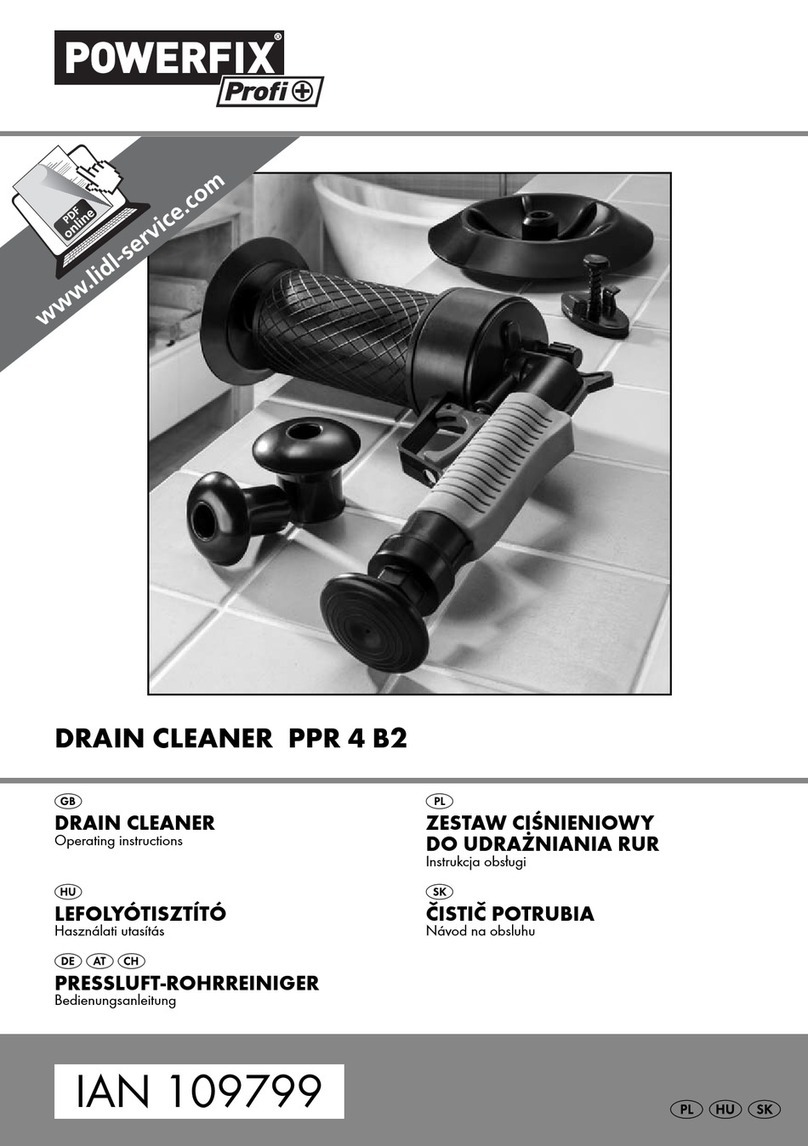
Powerfix Profi
Powerfix Profi PPR 4 B2 operating instructions

iGear
iGear Ultra Kill quick start guide

cecotec
cecotec CONGA THUNDERBRUSH 520 instruction manual
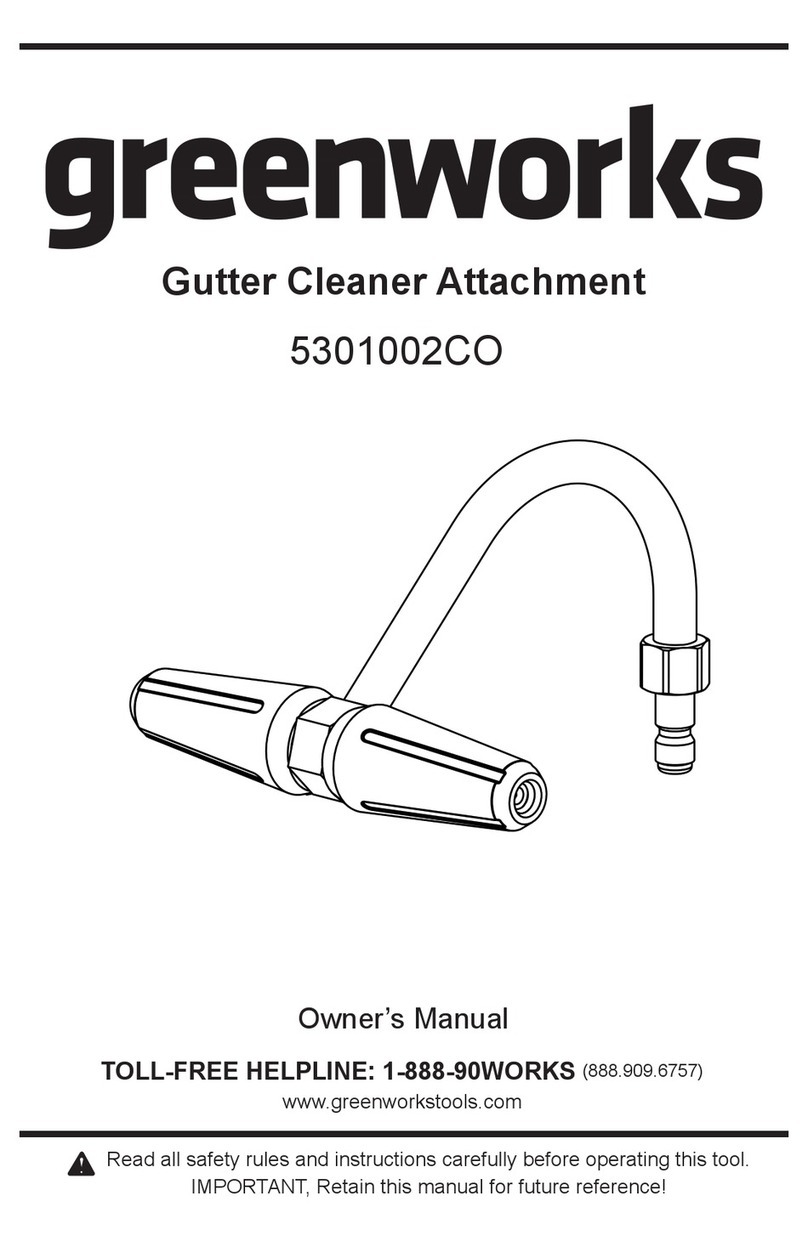
GreenWorks
GreenWorks 5301002CO owner's manual

Nilfisk-Advance
Nilfisk-Advance Roof Cleaner Instructions for use
